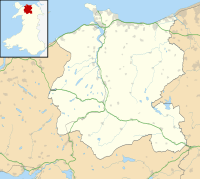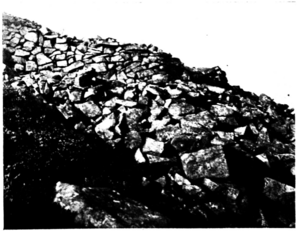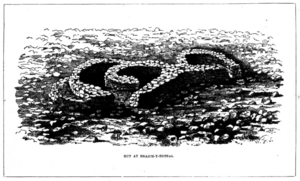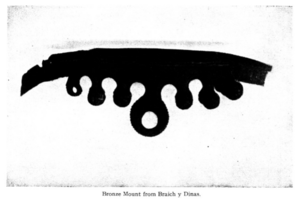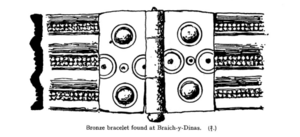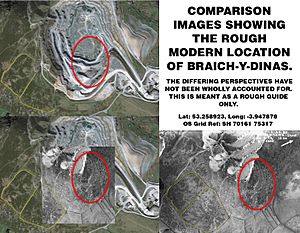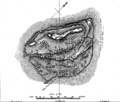Braich-y-Dinas facts for kids
Quick facts for kids Braich-y-Dinas |
|
|---|---|
| Penmaenmawr, North Wales | |
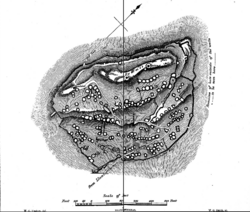
Braich-y-Dinas
|
|
| Coordinates | 53°15′39″N 3°56′56″W / 53.260721°N 3.9488339°W |
| Type | Hillfort |
| Site information | |
| Condition | Destroyed |
| Site history | |
| Materials | Stone |
| Airfield information | |
| Elevation | 351 m (1,152 ft) AMSL |
Braich-y-Dinas was a huge hill fort located at the top of Penmaenmawr mountain in North Wales. It was once thought to be the best-preserved and most complete hill fort in North-West Wales. However, it completely disappeared in the first half of the 1900s. This happened because of massive quarrying work by the Darbishire family. The quarrying destroyed all traces of the fort, even though people tried to save it.
Contents
What Braich-y-Dinas Looked Like
One of the first people to write about the fort was Thomas Pennant. He visited the site between 1778 and 1783. He said the mountain was 1545 feet tall and noted how well the fort was kept.
The top of the hill was protected by huge walls made of rough stones. These walls were up to 9 feet high and 8 to 15 feet thick. Inside the fort, there were more than 90 huts. Most of these huts were oval-shaped and about 10 to 20 feet wide. Their walls were also made of stone and were about 5 or 6 feet thick.
Another person, Thomas Pownall, wrote in 1771 about stone piles, called cairns, on the hilltop. These cairns might have been from the early Bronze Age, around 2000-2500 BC. This means people were active on the site a very long time ago. The area is also known for its Neolithic activity. A large axe factory, called Graig Lwyd, was found nearby.
Most objects found at the fort were from AD 100–400. However, experts now think the fort was built in several stages over time. The richest people living in the fort seemed to live between the outer and middle walls. This is where fancy pottery and most of the coins were found.
An Eyewitness Account from 1845
An Archaeologia Cambrensis writer, Harry Longueville Jones, described the fort in 1845: "When we reached the fortified British post of Braich y Dinas, on the top of Penmaen Mawr, we found the stone walls still complete in some places. They were about 12 to 15 feet high and 12 feet thick. They were made of loose stones, just piled up by people, not carefully built. There was no sign of mortar. Between the walls, and inside the main area, especially on the northeast side, were many small round cells, or huts. These were likely homes for the people living in this fort, similar to others found on the Caernarvonshire hills. Some were very well preserved, and one near the northwest entrance still had its roof. We couldn't go inside, and we didn't want to move the stones."
Amazing Discoveries at the Site
Many interesting items were found at Braich-y-Dinas. These include a bronze mount, which might have been part of a handled cup. Two matching bronze bracelets were also found. They had designs of circles, which experts believe were Celtic, not Roman.
Other finds that help us date the fort include:
- A Bronze Age spearhead with a loop.
- Roman coins featuring Emperors Nerva (ruled 96-98 AD), Trajan (ruled 98-117 AD), and Hadrian (ruled 117-138 AD).
- Many pieces of pottery, mostly from the late 1st and early 2nd centuries AD. Some were from as late as the 3rd and 4th centuries AD.
- A large saddle quern, which was used for grinding grain.
- A sandstone spindle whorl, used for spinning thread.
These finds tell us that people lived and worked at Braich-y-Dinas for a very long time, from the Bronze Age through the Roman period.
Efforts to Save the Ancient Site
In 1908, King Edward VII set up a Royal Commission. Its job was to list and protect old buildings and sites in Wales. Starting in 1909, this new commission tried to save Braich-y-Dinas. The site was already being destroyed by the Darbishire family's quarrying.
Local newspapers in June 1909 reported that W. Llewelyn Williams, a Member of Parliament (MP), spoke to the Prime Minister about Braich-y-Dinas. However, he was told that the 600 jobs at the quarry were more important than the ancient remains.
After failing in Parliament, people tried to get the public to pressure the quarry company. In 1910, an article about the destruction of Braich-y-Dinas appeared in a British newspaper called The Sphere. This story was even picked up by The New York Times in America!
Despite these efforts, the site was going to be destroyed. So, members of the commission visited Braich-y-Dinas many times. They wanted to record as much as they could before it was gone forever. Harold Hughes carried out a detailed survey for the Cambrian Archaeological Association.
The Sad End of Braich-y-Dinas
In February 1912, during a meeting of the Royal Commission on the Ancient and Historical Monuments of Wales, it was confirmed that blasting was happening at Penmaenmawr. Mr. William Henry More, who managed the land for the Crown, said that the quarry's lease did not include any rules to protect the fort. He also claimed that the quarry could not expand in any other direction.
There was some confusion about how much damage had already been done. Mr. More first said the quarry's impact was "small." But later, he admitted that much of the fort must have already been destroyed due to recent quarry expansion. He also admitted that the lease actually covered the "whole of the camp," not just a small part.
An RAF aerial photograph taken in 1923, eleven years later, still showed much of the camp. The shapes of over 50 huts were still visible on the mountainside. Finds were even being recorded from the site until at least 1934. However, the quarrying continued until the entire fort was gone.
Braich-y-Dinas Today
Today, nothing at all remains of the hill fort at Braich-y-Dinas. It was completely destroyed by the quarrying.
Images for kids


